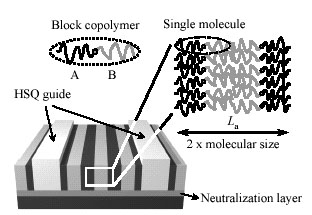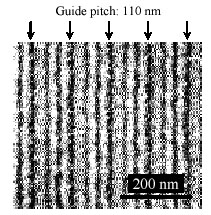Block Copolymer Lithography toward 16-nm-technology Nodes
Toru Yamaguchi and Hiroshi Yamaguchi
Physical Science Laboratory
Block copolymer lithography (BCL) has attracted considerable attention
as a combined top-down/bottom-up approach to nanopatterning. It involves
the use of microphase-separated nanometer-sized domains of block copolymers
as lithography templates. In recent times, the significance of BCL in the
field of lithography is particularly increased due to the fact that top-down
lithography will soon be reaching its limit in the 22-nm regime, necessitating
the development of innovative technologies. BCL has great potential for
exceeding the resolution limit of the state-of-art top-down lithography
because its resolution is determined solely by the molecular size of the
block copolymer. The most important challenge in BCL is the achievement
of a strict control on the alignment of various microphase-separated domains.
Among these domains, vertical lamellar domains composed of alternating
stacked layers of two dissimilar polymer chain blocks A and B (Fig. 1)
have critical advantages as lithography templates for nanodevice fabrication
on account of their line shape, high aspect ratio, and wide flexibility
in pattern configuration. However, the difficulty encountered in the formation
of vertical lamellae was that the lamellar interface should be aligned
in two directions, perpendicular to the substrate surface and parallel
to the lithographically created features.
Here, we report our novel method of aligning lamellar domains by means
of graphoepitaxy using a resist pattern as an alignment guide [1]. Graphoepitaxy
is a technique that uses the surface topography of the substrate to direct
the epitaxial growth of the block copolymer film. The key to its success
is the combination of the neutralization of a bottom surface and the introduction
of a hydrophilic guiding pattern; this makes it possible to independently
control the surface affinity of the substrate surface and the sidewall
surface of the guiding pattern, which leads to the vertical orientation
and lateral alignment of lamellar domains, respectively (Fig. 1). We have
successfully demonstrated that the lateral alignment of the lamellar structure
of a symmetric poly(styrene-b-methyl
methacrylate) is achieved in confined spaces of about 3La (La:
laterally aligned lamellar period, La 〜 32 nm) between hydrogen silsesquioxane (HSQ) resist patterns on a neutral
surface (Fig. 2). It is important to consider that a lamellar structure
with a period shorter than the pitch of the guide pattern could be formed
by this method. We believe that the combination of the artificial layout
of the guide patterns and the best polymer materials could lead to a new
type of high-resolution lithographic technology in the 16-nm (1/2 La) regime.
[1] T. Yamaguchi and H. Yamaguchi, J. Photopolym. Sci. Technol. 19 (2006) 385.
 |
|
 |
| Fig. 1. |
Lateral alignment of lamellar domains. |
|
|
| Fig. 2. |
AFM phase image of aligned domains. |
|
[back] [Top] [Next]

